The 21st century is the digital age, and the demand for digital consumer products is growing at an alarming rate. Among these products, the proportion of video products is quite large, and it is becoming more and more popular in people's daily life. Among these products, whether it is a digital camera or a mobile phone with camera function, the core part is the audio and video processor. The choice of processor determines the cost, performance and market prospect of such products.
This article refers to the address: http://
In this design, the author selected TI's TMS320DM270 (DM270) as the core processing chip.
Feasibility Analysis
In order to enable consumers to obtain higher quality digital video and video content, it is aimed at digital cameras, digital video cameras and portable multimedia products with a pixel count of 3 million to 5 million pixels. Texas Instruments has introduced the DSP-based digital media processor DM270, which is based on a multi-processor architecture with a dual-core architecture integrating the DSP C5409 and the 32-bit RISC processor ARM7TDMI, where the ARM7TDMI handles non-imaging functions for use as The main controller of the entire system, the DSP handles audio and video coding, and also integrates an image processing engine (iMX) dedicated to performing motion estimation and compensation in DCT, inverse DCT, and many other processing operations, as well as variable length coding. Decoder (VLCD).
And TI also offers a range of audio and video chips that can be seamlessly connected to the DM270. The TVP5040, TVP5145 can be used as a video A/D converter, and the AIC23 can be used as an audio A/D.
The DM270 also has a dedicated MMC/SD controller for external MMC/SD card expansion, which provides convenience for large-capacity data storage, as well as OSD (on screen display) module, which can directly connect external display devices (LCD, TV). .
The basic system framework of the digital camera based on DM270 is shown in Figure 1.
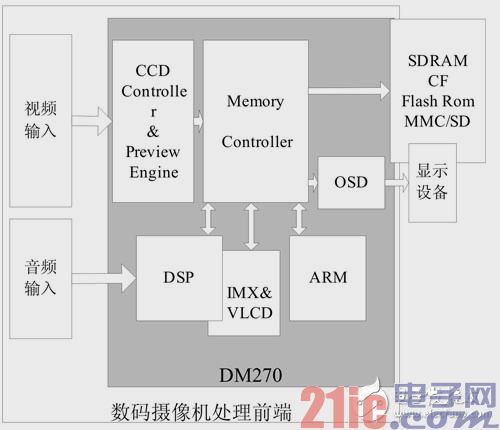
Figure 1 System diagram of the scheme
Design
As can be seen from Figure 1, the entire system front end is mainly composed of a video input module, an audio input module, and a processor DM270. The back end can access storage devices and display devices (LCD, TV).
Video module
The video input module structure is shown in Figure 3. The data is collected by the front-end CCD module. After entering the CPU, it is pre-processed, and then the video data is compressed and saved.
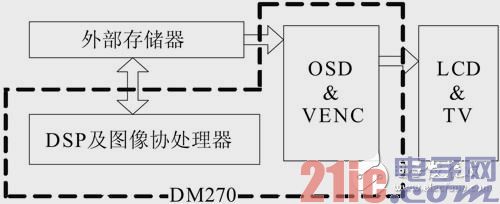
Figure 3 video playback data stream

Figure 4 Interface between McBSP and AIC23
Video capture and input
The DM270 has a CCD programmable control interface that allows easy access to standard CCD (CMOS) data to the system and provides the necessary timing logic for CCD image sensors for progressive and interlaced CCD or CMOS images. The sensor is well supported and can support up to 4096*4096 pixels. In the system developed by the author, the OV7620 CMOS camera is used, and the YUV data is output directly into the system. There is also a hardware 3A module inside the chip to automatically adjust the focus of the lens. In addition, the DM270 has a preview engine that enhances the image of the CCD data, automatic white balance and scaling of various sizes. This greatly reduces the CPU's primary processing pressure on the data.
Video compression
The DM270 supports MPEG4 30fps real-time codec at VGA resolution and supports multiple video compression standards such as JPEG, motion-JPEG, and H.263. A variety of shooting modes are available for digital video cameras.
As mentioned earlier, the DM270 also has an image coprocessor iMX inside, which can perform DCT, motion estimation (compensation), and interpolation operations at high speed. The VLCD module performs code stream coding. In the platform developed by the author, MPEG4 MPEG4 per second 24 frames, H.263 30 frames per second real-time compression encoding and decoding can be achieved through LCD display.
In addition, in addition to video images, digital photo capture can also be implemented to capture JPEG images. A 2048*1536 JPEG image can be implemented in the platform developed by the author.
Video output display
The digital camera must have a cashback function, while the DM270 has an OSD controller with a VENC (video encode) and D/A conversion module at the back end to generate NTSC or PAL format video signals for output to external display devices. The DM270 will compress the MPGE4 data or JPEG pictures, and the decoded YUV data will realize the recall function through the OSD. Its data flow is shown in Figure 3.
The OSD module has 4 image layers (two YUV video layers and two bitmap layers), which can easily realize layer stacking of layers. The OSD bit layer 0 can be used to display various operation menus as a graphical interface for the user to adjust system parameters. As can be seen from Figure 1, the audio data is directly input to the DSP in the DM270 for processing.
Audio capture and input
The DSP inside the DM270 is the 5409, which has two multi-channel buffered serial port (McBSP) modules for the audio acquisition interface. In the platform developed by the author, the audio sampling and conversion uses the AIC23 chip. The TLV320AIC23 is a high-performance stereo audio CODEC from TI. It has a built-in secondary output amplifier that supports both MIC and LINE IN input modes (2 out of 1) and programmable gain adjustment of the input and output. AIC2 analog-to-digital and digital-to-analog conversion are highly integrated inside the chip, and advanced Sigma-delta oversampling technology provides 16-bit, 20-bit, 24-bit, and 32-bit sampling in the 8 to 96 kHz frequency range. The input-output signal-to-noise ratio can reach 90dB and 100dB, respectively. It provides a guarantee for the sound quality of digital video cameras. Moreover, the AIC23 and the McBSP inside the DSP can be seamlessly connected. Its interface is shown in Figure 2.
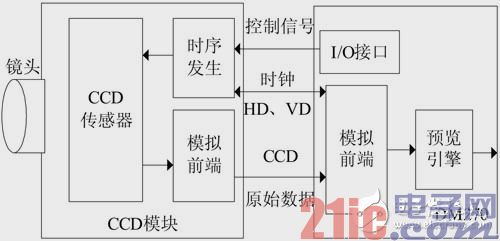
Figure 2 video input module structure
Audio compression, decoding
In the DM270, the computing power of the DSP is powerful, and a variety of voice compression coding and decoding can be realized. The table below is a comparison of several speech coding methods.
It can be seen from the table that the algorithm complexity of G.711 and G.726 is relatively simple in the case of ensuring high sound quality, which can reduce the data processing pressure of the DSP and enable the DSP to have more resources for processing the video data. And G.711 data can be supported by QuickTime format audio and video files, which can increase the digital camera file support format. G.726 is a variable rate encoding, and digital camera users can choose according to the storage space.
On the platform developed by the author, the G.711 and G.726 algorithms and the recording and playback functions of QuickTime files are implemented respectively.
System software design
In the system developed by the author, because the ARM core of DM270 is ARM7TDMI and there is no memory management unit (MMU), uClinux is used as the embedded operating system. Compared with standard Linux, the biggest feature of uClinux is that it does not have MMU, so it is suitable. Those processors that do not have an MMU. Because the kernel of uClinux is cut and modified by Linux according to the CPU to be run. It maintains the main advantages of the original Linux system, such as good stability, excellent file system support, perfect application development, and easy upgrade.
The software platform architecture of the program is shown in Figure 5.
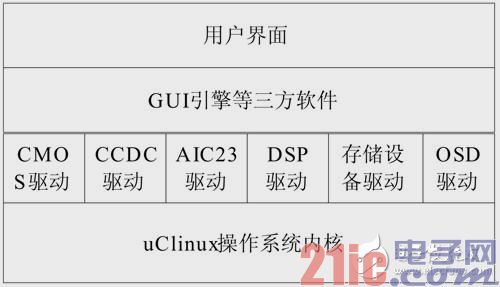
Figure 5 software architecture diagram
There are three main functions in the user application: the recording function, the camera function, and the playback function of the video and photos.
And real-time mutual switching of three functions can be realized. As shown in Figure 6.
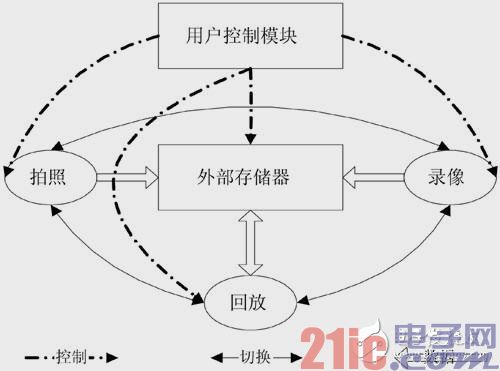
Figure 6 system user program function switch
In the solution software system, U-boot is also transplanted for system booting and loading, which improves the operating efficiency of the whole system.
Provides good support for product system upgrade services.
Conclusion
The system has been implemented in the School of Information and Electrical Engineering of China Agricultural University. It can perform MPEG4, motion-JPEG recording, JPEG photography, and QuickTime format recording. It also realizes the above-mentioned video recording and camera playback functions on LCD and TV. Practice has proved that this high-performance, DSP-based and ARM dual-core technology solution makes product development and application easier, and the system software used can be upgraded at any time, can be customized according to user requirements, and even DIY, The product has laid the foundation as soon as it enters the market.
ZOOKE provides you with safe and reliable connector products, with 4.14 spacing products providing more possibilities for limited space and creating more value for the research and development and production of terminal products.
4.14 wire to board connectors,4.14 connectors,ZOOKE connectors
Zooke Connectors Co., Ltd. , https://www.zooke.com
